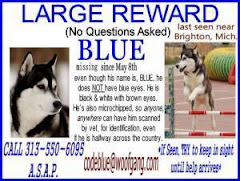
Nature is on the move this month, and Ari’s keeping watch. The pup has become increasingly vigilant since Cam’s death, and she spends most of her indoor time wobbling on the thin back of our sofa, where she can keep watch out our living room windows. Our couch, meanwhile, has taken on an identity of its own and looks far more like an abominable snow something than it does forest green furniture. Thick tufts of white fur undulate in the breeze, giving the appearance of underwater vegetation. Except, of course, for the annoying fact that kelp tends not to adhere to wool pants.
Our new canine vegetation has taught us an important new fact about mature huskies: they shed. A lot. So much so, in fact, that those in the know refer to this twice-annual husky molt as ‘blowing their coats.’ I wish this were merely an evocative metaphor. Instead, it’s the burdensome reality of a juvenile dog turned dandelion top. Thick balls of Ari’s undercoat float through the air in our house, eventually alighted on the carpet, the dining room table, the husband and, of course, the much-suffering sofa.
In another context, this might be whimsical or even picturesque. It might even be ecologically elegant. If, for instance, Ari were Timothy Grass (Phleum pratense) or other late-flowering flora, she’d be dispersing her seeds for germination next year. If she were common milkweed (Asclepias syriaca), she’d be feeding monarch butterflies and delighting children with her airborne silks. She’s not, of course.
Instead, she’s a half-husky who has inherited her father’s immensely effective insulating fur. Like her close kin the gray wolf, Ari has two coats: a thick undercoat of short hairs close to her body and coarser guard hairs on top. The undercoat keeps her body warm in temperatures as low as -75° F. Part of why this coat is so effective is because she completely replaces it twice a year. And that, of course, means that she has to lose it then, too. This makes her grumpy, and she pulls at the clumps of fur with irritation. She looks awful, and I think she knows it.
Further incensing her is the increased activity around our house. Although the pup has never been all that territorial, the increased movement of animals preparing for winter seems to concern her. She barks menacingly whenever another animal passes through our yard, regardless of whether or not that animal might be a threat. Of particular concern to her right now are three feral cats who occasionally cross our driveway on their way to some secret location. Each time they do, Ari raises her hackles, bares her teeth, and acts as if a massive invasion is immanent. Our brief morning reprieve has been interrupted by the schedule of these cats, who invariably wander down the driveway just before dawn.
Where they are returning to and how they spend their daylight hours remains a mystery to us. Like most of the animals in our area, these cats are too wily to be seen on one of our caninaturalist walks. We must resort, as Ari does, to stakeout positions near the front of the house, where we can watch the kitty debauchers slink home after a long and tawdry night of vole hunting and free love. They are wily and loose, these cats, and far too clever to let us know much about their wild lives.
We’re both surprised, then, when we see a small cat resting on the edge of the street early one morning. I stop us quietly and make the now-familiar gesture of reeling in Ari’s leash tightly around my hand, but the cat does not move. We walk closer to investigate, only to learn that the kitten—no more than a month or two old I’d guess—has become another victim to too much traffic travelling too fast on a dark country road. Trussed in a glossy black coat, she is beautiful and sleek, even lying broken in the middle of the road. Ari forgets to be fierce about this creature, who is undoubtedly the offspring of one of the pup’s new nemeses. Instead, she sniffs the kitten gingerly, then pulls back in alarm when she reaches the kitten’s fractured skull and dislocated eye. Can she tell this was an unnatural death?
Meanwhile our neighbor, Elizabeth, drives by on her way to work. Her car idles as she looks down at the cat and shakes her head sadly.
“Not another one,” she says. Her voice is full of real regret.
“Do you know this cat?” I ask. “Does she belong to anyone?”
Elizabeth shakes her head again. “I’ve seen a new feral family around here the past few days, but I haven’t been able to get close. I’m sorry.”
She apologizes—she is late to work. Otherwise, she would stay and help.
I tell her I understand. And the kitten is so small, I’m certain I can take care of its burial by myself.
“Too bad,” Elizabeth says by way of conclusion. “We’ve had a lot of these accidents lately.”
We agree. Too many.
As I watch Elizabeth’s Subaru drive down the long road, I decide I’ve had enough. Enough death, enough grieving, enough proof of the fragility and fallibility of life in our neighborhood. I turn Ari around and return to the house. Greg looks up from his morning work, surprised by the shortness of our walk and the militaristic determination of my entrance. I tell him about the kitten as I search for a copy of the week’s newspaper, which I will need to collect the broken little cat.
Wordlessly, Greg leaps from the couch and puts on his shoes. He takes my hand as we walk down the driveway and turn in the direction of the cat. We kneel down before her. She is nearly weightless; although her condition requires both of us to maneuver her onto the Business section. We fold the pages in as if the kitten were a package about to be mailed, and then we bury her in the rock wall along the side of the road.
Afterwards, Greg hugs me. He knows I am still smarting over Cam, and I get the sense he wants to allay any grief. But this time I’m not feeling grief. I pull away from him, my jaw set.
“We have to help them,” I insist.
Greg nods warily. Is this the deranged insistence of a grief-stricken pet owner? The messianic complex of someone who has been thinking about animals for too long? His expression is indulgent, as if worried he might further agitate me.
“Okay, hon,” he says slowly. “We can try to figure out something.”
“No,” I insist. “We have to help them NOW. We have to save them.”
The look on my face tells him I’m about to go home and rifle through our closet until I find tights and a cape. The look he gives me suggests clothing of the straight-jacket variety might be more appropriate. Too late: I will not be dissuaded.
I spend the rest of the morning visiting shelter and cat rescue websites. Greg and Ari take turns sighing despondently from their respective corners of the house. They are united in their apprehension over my behavior. I begin sighing too, but more out of despair concerning the current state of the domestic cat than anything else.
Eventually, though, I find an organization called Save our Strays, which places homeless cats in foster homes until they are fully socialized and can be adopted. It seems a wonderfully humane solution to the overcrowding of so many animal shelters, and their success in socializing young ferals seems like an accomplishment worth supporting.
SOS lists dozens of cats available for adoption in our area. I read the bio of each one, looking for clues about who might enculturate the most smoothly into our home. I rule out all tabbies on principle: they look too much like Cam, and I know I will spend at least our first few weeks wishing they were her. I rule out most older cats for related reasons: given Cam’s stress over Ari’s introduction, I worry that an older cat will be equally as distressed by the prospect of living with my ebullient caninaturalist. From there, my decision making becomes far more capricious, as I look for well-written descriptions and interesting cat photos. I feel like I am participating in an on-line dating service. In a way, I suppose I am.
Eventually, I email a foster cat parent named Cheshire. I decide that with a name like that, she must have a good sense of cats. Her email address is that of a local college, and I appreciate the lyricism of her descriptions. In my introductory letter, I tell her about the three of us and ask if she knows of a young cat who might enjoy living with such a family.
She writes back an hour later to tell me that she has the perfect cat for me. Her name is Mouse—a yearling cat who was recently rescued along with her three siblings. Cheshire describes Mouse as very curious, adventuresome, and busy. A real character.
I ignore Cheshire’s coded language about Mouse being “a character,” as well as her more overt warning about Mouse’s fondness for chewing paper. Instead, I take down the website address that features a picture of Mouse and visit the site at once. There, I find the image of a jester of a cat. Not quite calico, not quite tortoiseshell, Mouse wears motley. Her face is a swirl of black and brown, with a bright orange stripe rising from her nose to a point between her ears. She also has the biggest, most speckled ears I have ever seen. I am enthralled and delighted by her carnivalesque appearance. I write to Cheshire and tell her I think Mouse is beautiful. She sends me an adoption application, which I tuck away in my saved email folder. Meanwhile, I slink upstairs to the loft, where Ari is napping and Greg is studiously writing. They both look up and become instantly dubious.
“You’ve found something,” Greg says.
“Not something,” I correct. “Someone.”


















1 comments:
This passage reminds me of Sandra Steingraber's Having Faith: An Ecologist's Journey to Motherhood because of how beautifully it describes your (human) relationship. Have you read? Definitely worth a look! OK, and while I'm recommending things, I've been hoping that someone else will read Donna Haraway's book on dogs and then tell us all about it. Please please please...? :-)
Post a Comment